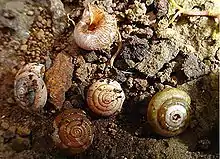Erepta
Erepta ist eine Gattung von Landlungenschnecken aus der Familie Helicarionidae. Ihr Verbreitungsgebiet erstreckt sich auf Mauritius und Réunion. Die Gattung umfasst drei rezente und vier ausgestorbene Arten.
| Erepta | ||||||||||||
|---|---|---|---|---|---|---|---|---|---|---|---|---|
_-_Helicarionidae_-_Mollusc_shell.jpeg.webp)
Zwei Gehäuse von Erepta stylodon im Museum Naturalis. | ||||||||||||
| Systematik | ||||||||||||
| ||||||||||||
| Wissenschaftlicher Name | ||||||||||||
| Erepta | ||||||||||||
| Albers, 1850 |

Merkmale
Die Gehäusehöhe beträgt 6 bis 9 mm, der Gehäusedurchmesser 9 bis 10 mm. Das Gehäuse ist gedrückt-kegelförmig, ziemlich dünn, durchscheinend und hat eine nahezu konische Kontur der Spitze. Es gibt fünf bis sechs mäßig gewölbte Windungen. Die Endwindung ist gerade und rundlich. Die Gehäusefärbung ist kornfarben. Manchmal haben die Gehäuse ein dunkleres Band über der Peripherie des Umgangs. Die Embryonalwindungen haben deutliche, regelmäßige Spiralbänder. Die späteren Windungen haben feine, unregelmäßige Radialstreifen mit mikroskopischen, glatten Spirallinien.
Systematik
Erepta wurde 1850 von Johann Christoph Albers als Untergattung der Gattung Stylodonta aufgestellt.[1] Die Typusart ist Helix stylodon (Pfeiffer, 1842). 1908 wurde Erepta von Henry Haversham Godwin-Austen zur eigenständigen Gattung erhoben.[2] Erepta stand im Verlauf ihrer taxonomischen Geschichte in verschiedenen Familien. Godwin-Austen stellte 1908 die neue Unterfamilie Ereptinae innerhalb der Familie Zonitidae auf.[2] Louis Germain transferierte Erepta als Untergattung der Gattung Microstylodonta im Jahr 1921 in die Familie Ariophantidae.[3] In der Folgezeit kam Erepta in die Familie Helicarionidae, bevor sie 2002 erneut in die Familie Ariophantidae gestellt wurde.[4] Die gegenwärtig akzeptierte Systematik basiert auf Philippe Bouchet und Jean-Pierre Rocroi,[5] die im Jahr 2005 die Unterfamilien Ereptinae und Helicarioninae miteinander synonymisierten.
Folgende Arten sind bekannt:
- Erepta stylodon (Pfeiffer, 1842)[6][1]
- Erepta odontina (Morelet, 1851)[7]
- Erepta setiliris (Benson, 1859)[8]
- † Erepta thiriouxi (Germain, 1918)[9]
- † Erepta wendystrahmi Griffiths, 2000[10]
- † Erepta chloritiformis Griffiths & Florens, 2004[11]
- † Erepta pyramidalis Griffiths & Florens, 2004[11]
Die Art Pseudophasis nevilli stand ebenfalls längere Zeit in der Gattung Erepta, bevor Anatolij A. Schileyko im Jahr 2002 Germains Untergattung Pseudophasis aus dem Jahr 1918[12] zur monotypischen Gattung erhob und Erepta nevilli dort hinein transferierte.[13]
Status
Ereptila wendystrahmi, Erepta chloritiformis, Erepta pyramidalis und Erepta thiriouxi sind nur subfossil bekannt und gelten als ausgestorben. Erepta stylodon ist vom Aussterben bedroht und kommt in einem nur 10 ha großen Areal am Montagne Brise Fer auf Mauritius vor. Erepta odontina kommt in Wäldern an den Bergen Le Pouce, Black River Peak, Montagne Savanne, Pieter Both sowie Montagne Cocotte vor und gilt als stark gefährdet. Erepta setiliris ist auf Mauritius ausgestorben, überlebt jedoch auf Réunion. Ihr Status wird als stark gefährdet klassifiziert.
Literatur
- Anatolij A. Schileyko: Treatise on recent terrestrial pulmonate molluscs. Part 9, Helicarionidae, Gymnarionidae, Rhysotinidae, Ariophantidae. Ruthenica, Supplement 2, 2002, S. 1236.
- Owen Lee Griffiths, Francois Benjamin Vincent Florens: A Field Guide to the Non-Marine Molluscs of the Mascarene Islands: (Mauritius, Rodrigues and Reunion) and the Northern Dependencies of Mauritius, Bioculture Press, Mauritius, 2006, S. 122–124
Einzelnachweise
- Johann Christoph Albers: Die Heliceen nach natürlicher Verwandtschaft systematisch geordnet, 1850, S. 109.
- Henry Haversham Godwin-Austen: On the animals of genera and species of Mascarene land-mollusca belonging to the family Zonitidæ, collected by Monsieur E. Dupont. The Annals and magazine of natural history; zoology, botany, and geology, Volume 2, Series 8, 1908, S. 422–436
- Louis Germain: Faune malacologique terrestre et fluviatile des Iles Mascareignes. Angers, Imprimerie F. Gaultier et A. Thébert, 1921, S. 123–128.
- Anatolij A. Schileyko: Treatise on recent terrestrial pulmonate molluscs. Part 9, Helicarionidae, Gymnarionidae, Rhysotinidae, Ariophantidae. Ruthenica, Supplement 2, 2002, S. 1236.
- Philippe Bouchet, Jean-Pierre Rocroi: Part 2. Working classification of the Gastropoda. Malacologia, 47: 239–283, Ann Arbor 2005 ISSN 0076-2997
- Ludwig Pfeiffer: Symbolae ad historiam heliceorum, Band 2, 1842, S. 40
- Arthur Morelet: Testacea Africae insularis a CI. Vesco collecta et ab A. Morelet descripta. Revue et magasin de zoologie pure et appliquée, Series 2, Volume 3, 1851, S. 218–221
- William Henry Benson: XIII. — Descriptions of several new Land Shells from the Mauritius. The Annals and Magazine of Natural History, Volume 3, Series 3, 1859, S. 98–100
- Louis Germain: Sur la classification de quelques Mollusques Pulmonés des îles Mascareignes et description d’espèces nouvelles de cet archipel, Bulletin du Muséum national d’histoire naturelle, Band 24, 1918, S. 523.
- Owen Lee Griffiths: Nine new species of Mascarene land snails (Mollusca: Gastropoda), Molluscan Research, Volume 20 (2), 2000, S. 37–50
- Owen Lee Griffiths, F. B. Vincent Florens: Ten new species of Mascarene land snails (Mollusca : Gastropoda) and their conservation status Molluscan Research, 2004, 24, 161–177
- Louis Germain: Sur la classification de quelques Mollusques Pulmonés des îles Mascareignes et description d’espèces nouvelles de cet archipel, Bulletin du Muséum national d’histoire naturelle, Band 24, 1918, S. 520.
- Anatolij A. Schileyko: Treatise on recent terrestrial pulmonate molluscs. Part 9, Helicarionidae, Gymnarionidae, Rhysotinidae, Ariophantidae. Ruthenica, Supplement 2, 2002, S. 1239.